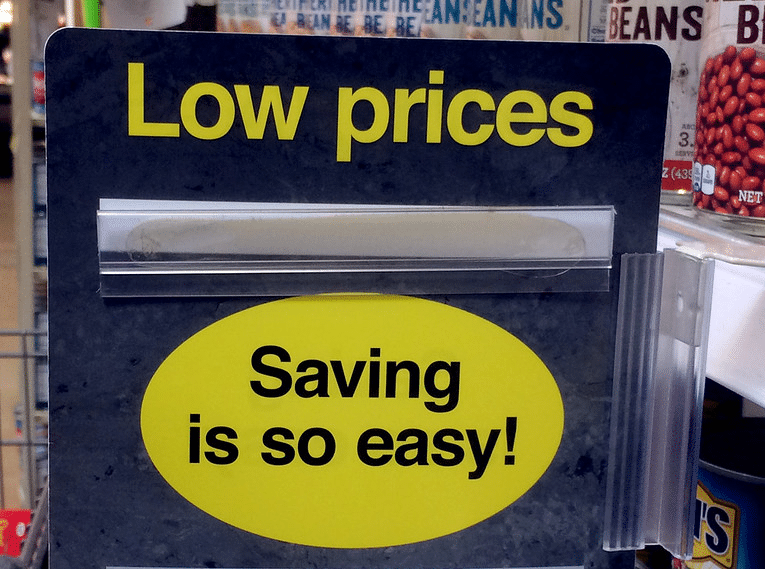
In times of economic uncertainty, interest in coupons has almost always risen. That hasn’t quite been the case the past few years, though. The number of available coupons has been steadily declining for a decade, and it wasn’t until last year when the number of coupons redeemed finally picked up – which perhaps says more about shoppers’ desperation for savings than about the quality of coupons that are out there.
But lately, several retailers are finding that asking their customers to clip coupons in order to save money isn’t exactly sending shoppers racing through the doors. So they’re trying something different – making up for several years of rising prices, by lowering them again.
Target became the latest to do so earlier this week, announcing that it would lower prices “on 5,000 frequently shopped items” over the course of the summer. But it’s far from alone. Earlier this month, ALDI announced it would lower prices on more than 250 items, in order “to pass along $100 million in savings through Labor Day.” Even regional grocery chains are getting in on the act, with the Washington DC-area Giant Food lowering prices on hundreds of store-brand grocery items.
Those big promises were accompanied by less splashy announcements from the likes of Costco, whose Chief Financial Officer said back in March that the club store was beginning to offer “price reductions where we can” on everything from batteries to bottled water to frozen fruit. “We always want to be the first out there trying to lower prices,” Richard Galanti told investors.
Walmart recently pointed out that its stores currently feature “almost 7,000 rollbacks,” with CEO Doug McMillon telling investors that “our combination of everyday low prices plus a large number of rollbacks is resonating” with customers.
Even Kroger wants in on the act, as it seeks regulatory approval for its planned merger with Albertsons, promising customers back in February that it “will invest $500 million to lower prices following the merger with Albertsons starting day one following the transaction close.”
Higher grocery prices have forced many inflation-weary shoppers to cut back on their spending. For retailers, the potential solution is a matter of simple math – cutting prices in order to sell more products, is preferable and more profitable than keeping prices high and selling far less. Especially these days, when many shoppers seem less inclined to do the work of clipping coupons and scouring weekly circulars in order to get the best deals.
Savvy Target shoppers had long been able to take advantage of special offers in the Target Circle loyalty program. But Target revamped the program last month, so everyone could pay the same price and get the same perks without first having to browse or activate most of the offers. The same is true of the lower prices announced this week – they’re across-the-board price cuts, available to everyone, not just loyalty program members or coupon clippers.
As for the other retailers that recently announced price cuts, Walmart is already known for its “everyday low prices” and doesn’t offer digital coupons or a traditional loyalty program. And ALDI and Costco don’t accept manufacturer’s coupons at all. So, just like Target, their lower prices aren’t gimmicks for those who know how to play the game, but actual price cuts they say will benefit everyone.
There’s been a lot of blame to go around the past few years – manufacturers have been criticized for raising their list prices long after supply chain challenges stabilized, while retailers have been criticized for the prices they charge shoppers while raking in record profits.
So who now gets the credit for all of these lower prices – retailers or manufacturers? In the case of ALDI, Costco and Giant, most, or all, of the new lower-priced products are store brands. That makes them that much more attractive than the higher-priced national brands.
As for Target and Walmart, they say their lower prices are a joint effort. “Suppliers participate in a majority of those, but not all of them,” Walmart’s McMillon said. “Our partners know our playbook,” Target Chief Growth Officer Christina Hennington said. When it comes to lowering prices and offering greater value, “they see us do that in our own brands, and they help us do that with their brand portfolio.”
While much of the lower-prices talk is accompanied by talk of wanting to offer a helping hand to shoppers during tough times, retailers wouldn’t be lowering prices at all if they didn’t think it would be good for business. For some, it’s about emphasizing their strengths. “Before the consumer was stressed with inflation, we were still about low prices,” ALDI U.S. CEO Jason Hart told ABC News this morning. “But those low prices become even more important as value is even more top of mind for the consumer.” For others, it’s about cutting their losses, as shoppers begin to stray. “Target is losing customers,” GlobalData Retail analyst Neil Saunders wrote in a note to investors. “No wonder there’s an investment in sharper prices.”
Regardless of the reason for the price cuts, though, they’re a welcome change from three years of inflation. And time will tell whether what’s good for shoppers turns out to be good for sellers as well.
Image source: Bill Smith










